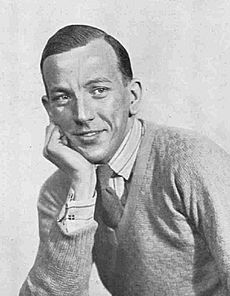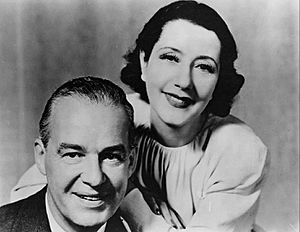Lynn Fontanne facts for kids
Quick facts for kids
Lynn Fontanne
|
|
|---|---|

Photograph by Carl Van Vechten, 1932
|
|
| Born |
Lillie Louise Fontanne
6 December 1887 |
| Died | 30 July 1983 (aged 95) |
| Occupation | Actress |
| Years active | 1905–1967 |
| Spouse(s) | |
Lynn Fontanne (born Lillie Louise Fontanne; December 6, 1887 – July 30, 1983) was a famous English actress. She became well-known in London's West End (a famous theatre district). Later, she met American actor Alfred Lunt. They married in 1922 and became a very popular acting team.
Lynn and Alfred starred together in many plays on Broadway in New York and in London for over 40 years. People often called them "The Lunts." They were celebrated on both sides of the Atlantic Ocean.
Fontanne was born in Woodford, which is now part of London. She learned acting from the famous actress Ellen Terry. Lynn Fontanne acted a lot in the United States, starting in New York in 1910. She performed in classic plays like The Taming of the Shrew and The Seagull. However, she and Alfred Lunt were most famous for their elegant performances in light comedies and romantic plays.
The Lunts stopped acting on stage in 1960. They lived at their home in Genesee Depot, Wisconsin. Lynn Fontanne passed away there at age 95, six years after her husband.
Contents
Life and career
Early acting years
Lynn Fontanne was born Lillie Louise Fontanne in Woodford, Essex, England, on December 6, 1887. She was the youngest of three daughters. A family friend introduced her to the leading actress Ellen Terry. Ellen Terry sometimes taught young, promising actors.
Thanks to Terry's training, Fontanne got roles in plays in London and on tour across England from 1905 to 1916. She first appeared at the Theatre Royal, Drury Lane, in 1905. She was in the chorus of the Cinderella pantomime (a musical play). Later, she was an extra (a non-speaking actor) in London shows.
In 1909, she toured as Rose in Lady Frederick. She also appeared in other London plays. In November 1910, she made her first trip to America. She debuted in New York in Mr Preedy and the Countess.
After returning to London in 1911, she acted in more plays. From 1912 to 1913, she toured as Gertrude Rhead in Milestones. In this role, she played the same character as a young woman, in middle age, and as an old woman. American star Laurette Taylor saw her and was very impressed. In 1914, Fontanne had a big success as Liza in My Lady's Dress. She acted in four more London shows in 1914–15. She was engaged to a lawyer named Teddy Byrne, but he was killed in 1916 during the First World War.
Broadway success
Before Teddy Byrne's death, Fontanne joined Laurette Taylor's acting company in New York. Taylor and her husband, Hartley Manners, helped Fontanne's career. After five plays with them, Fontanne started getting main roles for other theatre companies. From 1918 to 1920, she played leading roles in new plays on Broadway and in cities like Chicago and Philadelphia. During this time, she met actor Alfred Lunt in summer stock theatre (plays performed in the summer). They fell in love.
In 1920, Fontanne returned to London to act with Laurette Taylor. She quickly went back to the US to be with Lunt. In 1921, she had her first big success in a main role in the comedy Dulcy. She did not return to London for nine years.
In May 1922, Fontanne married Alfred Lunt. In 1923, they first appeared together on Broadway in Sweet Nell of Old Drury. Even though Laurette Taylor was the main actress, Fontanne impressed the critics. A critic named Alexander Woolcott said that Fontanne's performance was "something of fine mettle, something true and shining."
Joining the Theatre Guild
In 1924, the Lunts joined the Theatre Guild. This group put on serious and new plays on Broadway that other theatre companies often rejected. The first play they did for the Guild was The Guardsman. They became known for acting well in light comedies. They also acted together in three plays by Bernard Shaw: Arms and the Man (1925), Pygmalion (1926), and The Doctor's Dilemma (1927). Fontanne also showed her acting range in Eugene O'Neill's serious play Strange Interlude (1928).
Fontanne and Lunt introduced a new, natural way of speaking lines. They used "overlapping dialogue." This meant that one actor would start speaking before the other had completely finished. It was new for actors to do this. But, they were so skilled that the audience could hear every word. This made their scenes together feel more real and lively than other actors' performances.
In 1928, Fontanne and Lunt starred in Caprice. This play was a big step for them. It was the first time that audiences came to see them, not just the play. From then on, they always acted together. They took Caprice to London in 1930, where audiences and critics loved them.
For the Guild in New York, Fontanne and Lunt starred in Robert Sherwood's romantic comedy Reunion in Vienna in 1931. It ran for a whole season and then toured across the country. The Lunts believed in touring. They took many of their Broadway hits to smaller towns and big cities across America. They felt it was important for more people to see good plays.
Design for Living and other plays

Fontanne and Lunt were close friends with the English actor and writer Noël Coward. They met in New York in 1921. Coward wrote a comedy called Design for Living (1932) for the three of them. Because the three stars were so popular, the play broke box-office records. Fontanne and her co-stars reportedly earned the highest salaries on Broadway at that time.
The huge success of Design for Living led Coward to write another play for his friends. However, his play Point Valaine (1934) was not successful. Coward tried to write a serious drama, but the sad story and difficult characters did not appeal to audiences. People were used to seeing the Lunts in glamorous and romantic roles. This play was the only real failure in the Lunts' joint career.
Between the two Coward plays, Fontanne and Lunt performed Reunion in Vienna in London. It was a big success there too. The Times newspaper praised their acting, saying they kept the audience excited.
For the rest of the 1930s, Fontanne and her husband appeared in Theatre Guild plays. In 1935, they played Katherina and Petruchio in The Taming of the Shrew. In 1936, they starred in a new play called Idiot's Delight. In 1937, they played the main roles in Amphitryon 38. In 1938, they played Arkadina and Trigorin in The Seagull on Broadway. They also toured Amphitryon 38 a lot in the US.
The Lunts had a country home called "Ten Chimneys" in Genesee Depot, near where Alfred Lunt grew up. It was their summer home, and they hosted many theatre friends there. During the Second World War, Fontanne wanted to be in England to share the difficulties with her family and friends. So, from 1943 to 1945, the Lunts performed in London and for soldiers. They even toured army camps in France and Germany in 1945.
Later career and retirement

After the war, Fontanne and Lunt returned to the US and continued working with the Theatre Guild. In 1946–47, they appeared in Terence Rattigan's comedy Love In Idleness (called O Mistress Mine on Broadway). In 1949–50, they were in I Know My Love. These plays ran for many performances. The Lunts toured I Know My Love all over the US.
They went back to England in 1952 for their last play by Noël Coward, Quadrille. This was a romantic comedy. After a long run in London, they brought the play to Broadway in 1954.
Fontanne and Lunt's last Broadway premiere was in The Great Sebastians in 1956. After six months in New York, they toured the play across the US. Their final play was in 1957: The Visit. This play was about a rich old woman getting revenge. They toured this play in Britain in 1957–58. In May 1958, they opened the Lunt-Fontanne Theatre in New York with the same play. In June 1960, they opened the new Royalty Theatre in London. After a final week of performances in November, they retired from the stage.
Alfred Lunt passed away on August 3, 1977. Lynn Fontanne died at Genesee Depot on July 30, 1983, at the age of 95. She passed away from pneumonia and was buried next to her husband in Forest Home Cemetery in Milwaukee, Wisconsin.
Cinema and broadcasting
Lynn Fontanne, like her husband, did not enjoy acting for the camera very much. She only made four films. She appeared in the silent films Second Youth (1924) and The Man Who Found Himself (1925). For the film The Guardsman (1931), both she and Lunt were nominated for Academy Awards. They also had small roles as themselves in Stage Door Canteen (1943).
The Lunts starred in four television shows in the 1950s and 1960s. Both Lunt and Fontanne won Emmy Awards in 1965 for The Magnificent Yankee. Lynn Fontanne narrated a 1960 television show of Peter Pan. She also received another Emmy nomination for playing Grand Duchess Marie in Anastasia in 1967. These were some of the few times she appeared without her husband. The Lunts also acted in several radio plays in the 1940s. Many of these radio shows still exist today.
Honours and awards
In September 1964, Lunt and Fontanne received the Presidential Medal of Freedom. This is a very high award given by the President of the United States. They received it from President Lyndon Johnson at the White House. Lynn Fontanne was also a member of the American Theater Hall of Fame. She received a Kennedy Center Honor for the Performing Arts in 1980.
She did not receive an official British honour, which she wished for. She would have liked to be called Dame Lynn Fontanne. She said, "They thought I was American. But I was always British. I would have cherished the award." When she was 90, she received a standing ovation (everyone stood up and clapped) when she attended a performance of Hello, Dolly! at the Lunt-Fontanne Theatre.

See also
 In Spanish: Lynn Fontanne para niños
In Spanish: Lynn Fontanne para niños






